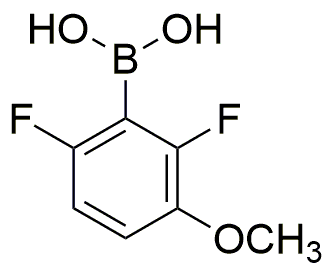2,6-Difluoro-3-methoxyphenylboronic acid is widely utilized in research focused on:
- Pharmaceutical Development: This compound serves as a key intermediate in the synthesis of various pharmaceuticals, particularly in the development of drugs targeting cancer and other diseases due to its ability to form stable complexes with biomolecules.
- Material Science: It is used in the creation of advanced materials, such as polymers and nanomaterials, enhancing properties like conductivity and mechanical strength, which are crucial in electronics and engineering applications.
- Organic Synthesis: The compound acts as a versatile reagent in cross-coupling reactions, facilitating the formation of carbon-carbon bonds, which is essential in the synthesis of complex organic molecules.
- Bioconjugation: Its boronic acid functionality allows for selective binding to diols in biomolecules, making it valuable in bioconjugation techniques for labeling and drug delivery systems.
- Environmental Chemistry: This chemical is also explored for its potential in environmental applications, such as the detection and removal of pollutants, owing to its reactivity and ability to form stable complexes with various environmental contaminants.
General Information
Properties
Safety and Regulations
Applications
2,6-Difluoro-3-methoxyphenylboronic acid is widely utilized in research focused on:
- Pharmaceutical Development: This compound serves as a key intermediate in the synthesis of various pharmaceuticals, particularly in the development of drugs targeting cancer and other diseases due to its ability to form stable complexes with biomolecules.
- Material Science: It is used in the creation of advanced materials, such as polymers and nanomaterials, enhancing properties like conductivity and mechanical strength, which are crucial in electronics and engineering applications.
- Organic Synthesis: The compound acts as a versatile reagent in cross-coupling reactions, facilitating the formation of carbon-carbon bonds, which is essential in the synthesis of complex organic molecules.
- Bioconjugation: Its boronic acid functionality allows for selective binding to diols in biomolecules, making it valuable in bioconjugation techniques for labeling and drug delivery systems.
- Environmental Chemistry: This chemical is also explored for its potential in environmental applications, such as the detection and removal of pollutants, owing to its reactivity and ability to form stable complexes with various environmental contaminants.
Documents
Safety Data Sheets (SDS)
The SDS provides comprehensive safety information on handling, storage, and disposal of the product.
Product Specification (PS)
The PS provides a comprehensive breakdown of the product’s properties, including chemical composition, physical state, purity, and storage requirements. It also details acceptable quality ranges and the product's intended applications.
Certificates of Analysis (COA)
Search for Certificates of Analysis (COA) by entering the products Lot Number. Lot and Batch Numbers can be found on a product’s label following the words ‘Lot’ or ‘Batch’.
*Catalog Number
*Lot Number
Certificates Of Origin (COO)
This COO confirms the country where the product was manufactured, and also details the materials and components used in it and whether it is derived from natural, synthetic, or other specific sources. This certificate may be required for customs, trade, and regulatory compliance.
*Catalog Number
*Lot Number
Safety Data Sheets (SDS)
The SDS provides comprehensive safety information on handling, storage, and disposal of the product.
DownloadProduct Specification (PS)
The PS provides a comprehensive breakdown of the product’s properties, including chemical composition, physical state, purity, and storage requirements. It also details acceptable quality ranges and the product's intended applications.
DownloadCertificates of Analysis (COA)
Search for Certificates of Analysis (COA) by entering the products Lot Number. Lot and Batch Numbers can be found on a product’s label following the words ‘Lot’ or ‘Batch’.
*Catalog Number
*Lot Number
Certificates Of Origin (COO)
This COO confirms the country where the product was manufactured, and also details the materials and components used in it and whether it is derived from natural, synthetic, or other specific sources. This certificate may be required for customs, trade, and regulatory compliance.


